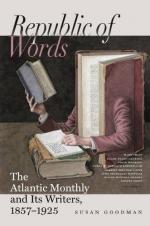My friend rides hard her hobby for choice editions, and she hunts with a will whenever a good old copy of a well-beloved author is up for pursuit. She is not a fop in binding, but she must have appropriate dresses for her favorites. She knows what
“Adds a precious seeing to the eye”
as well as Hayday himself, and never lets her folios shiver when they ought to be warm. Moreover, she reads her books, and, like the scholar in Chaucer, would rather have
“At
her beddes head
A twenty bokes, clothed in black and red,
Of Aristotle and his philosophy,
Than robes rich, or fiddle, or psaltrie.”
I found her not long ago deep in a volume of “Mr. Welsted’s Poems”; and as that author is not particularly lively or inviting to a modern reader, I begged to know why he was thus honored. “I was trying,” said she, “to learn, if possible, why Dicky Steele should have made his daughter a birth-day gift of these poems. This copy I found on a stall in Fleet Street many years ago, and it has in Sir Richard’s handwriting this inscription on one of the fly-leaves:—
“ELIZABETH STEELE
Her Book
Giv’n by Her Father
RICHARD STEELE.
March 20th, 1723.
“Running my eye over the pieces, I find a poem in praise of ‘Apple-Pye,’ and one of the passages in it is marked, as if to call the attention of young Eliza to something worthy her notice. These are the lines the young lady is charged to remember:—
“’Dear Nelly, learn with Care the Pastry-Art,
And mind the easy Precepts I impart:
Draw out your Dough elaborately thin.
And cease not to fatigue your Rolling-Pin:
Of Eggs and Butter see you mix enough;
For then the Paste will swell into a Puff,
Which will in crumpling Sounds your Praise report,
And eat, as Housewives speak, exceeding short.’”
Who was Abou Ben Adhem? Was his existence merely in the poet’s brain, or did he walk this planet somewhere,—and when? In a copy of the “Bibliotheque Orientale,” which once belonged to the author of that exquisite little gem of poesy beginning with a wish that Abou’s tribe might increase, I find (the leaf is lovingly turned down and otherwise noted) the following account of the forever famous dreamer.
“Adhem was the name of a Doctor celebrated for Mussulman traditions. He was the contemporary of Aamarsch, another relater of traditions of the first class. Adhem had a son noted for his doctrine and his piety. The Mussulmans place him among the number of their Saints who have done miracles. He was named Abou-Ishak-Ben-Adhem. It is said he was distinguished for his piety from his earliest youth, and that he joined the Sofis, or the Religious sect in Mecca, under the direction of Fodhail. He went from there to Damas, where he died in the year 166 of the Hegira. He undertook, it is said, to make a pilgrimage from Mecca, and to pass through the desert alone and without provisions, making a thousand genuflexions for every mile of the way. It is added that he was twelve years in making this journey, during which he was often tempted and alarmed by Demons. The Khalife Haroun Raschid, making the same pilgrimage, met him upon the way and inquired after his welfare; the Sofi answered him with an Arabian quatrain, of which this is the meaning:—




